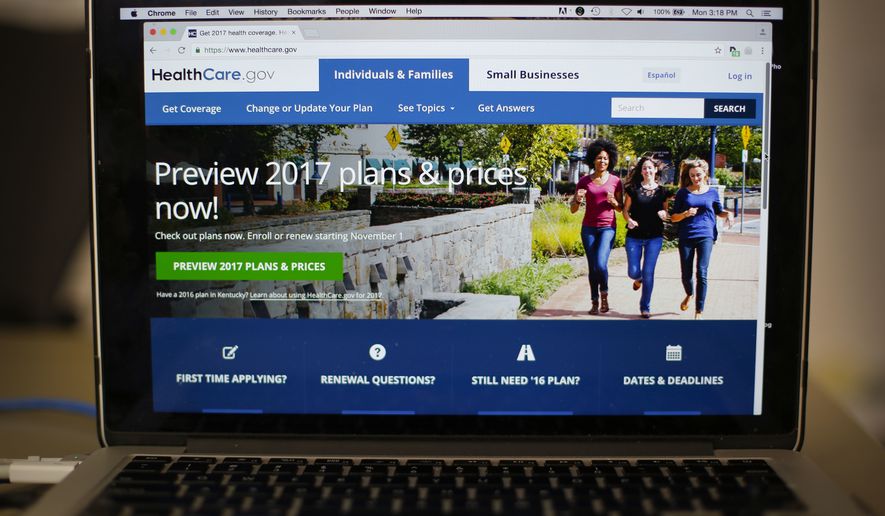President Trump’s sweeping order against Obamacare late Friday appears to give the new administration enough leeway to target the most unpopular aspect of his predecessor’s law — a mandate requiring Americans to get coverage or pay a fine, policy analysts said.
The executive order, issued hours after Mr. Trump was sworn in, also sets the stage for selling insurance across state lines and eyes “greater flexibility to states” in implementing health care programs, which are key tenets for Republicans looking to repeal and replace the Affordable Care Act alongside Mr. Trump.
Though the order has no immediate effect — many Obamacare provisions are written into law, and Mr. Trump’s health care team isn’t in place — congressional Republicans praised it as a symbolic step toward offering relief from the law’s soaring premiums and dwindling choices. Republicans will be using fast-track budget rules to gut the “individual mandate” and other parts of the law in the coming weeks.
“This action demonstrates that President Trump is committed to fixing the damage caused by Obamacare as soon as possible,” said Sen. John Barrasso, Wyoming Republican.
Republican leaders say they will repeal Obamacare and replace it this year with a plan that doles out fixed tax credits and unleashes market forces to entice people into health care coverage rather than relying on a mandate to force them into coverage.
Yet repealing the mandate before an alternative plan is in place could cause uncertainty for insurers participating in the program’s web-based exchanges, analysts said. The mandate is the main tool to pull healthy people into the marketplace to balance the costs for sicker customers who can no longer be denied insurance.
Certain people are exempt from the mandate, either because they do not earn enough money or because they fit certain categories — for example, they are in prison, are in the country illegally or take care of their own health care costs through faith-based health care ministries. Still others can qualify for one of 14 “hardship exemptions” issued by the Health and Human Services Department, such as a recent eviction, a bankruptcy filing or the death of a close family member, or if they were a victim of domestic violence.
That is where Mr. Trump would have some room to make changes, analysts said.
“Probably the biggest step implied by this order would be granting widespread hardship exemptions from the individual mandate penalty, which could create chaos in the individual insurance market,” said Larry Levitt, a senior vice president at the nonpartisan Kaiser Family Foundation.
Mr. Obama used executive action to delay parts of his signature health care law. On two occasions, he delayed the “employer mandate” requiring larger businesses to provide adequate health care coverage or pay crippling fines.
On Sunday, White House adviser Kellyanne Conway said Mr. Trump may stop enforcing the mandate on individuals. Normally, people who lacked insurance last year would pay the tax on their returns to the IRS this spring.
“He wants to get rid of that Obamacare penalty almost immediately, because that is something that is really strangling a lot of Americans to have to pay a penalty for not buying [insurance],” she told ABC’s “This Week.”
Though the mandate tax is $695 or 2.5 percent of qualified income for 2016, the penalty was phased in from a baseline of just $95 in 2014.
Too many people have chosen to pay a penalty instead of signing up under the program. The IRS says 6.1 million paid the Obamacare tax in 2015, while another 12.2 million claimed an exemption to avoid paying the tax or having coverage.
For now, however, Mr. Trump’s executive order will serve as an early messaging tool, said Timothy Jost, a law professor at Washington and Lee University in Virginia who closely tracks the health care debate.
He noted that sections of the order began with the words “to the maximum extent permitted by law,” signaling that there are constraints around the executive branch.
“What you do through executive orders is give a set policy direction. This doesn’t change anything at this point. … It means that we’re moving in a different direction,” he said.
Mr. Jost said it is unlikely that any tangible changes will be made until the Senate confirms Tom Price, Mr. Trump’s pick to lead HHS, and Seema Verma to lead the Centers for Medicare and Medicaid Services.
Consumers have until Jan. 31 to sign up for 2017 coverage on Obamacare’s exchanges, although Mr. Trump’s order could inject some uncertainty into the final days of the enrollment period.
Topher Spiro, vice president for health care policy at the left-leaning Center for American Progress, said Mr. Trump should not have resorted to “meaningless campaign messaging.”
“Rather than stoking anxiety, President Trump should ease the burden on the minds of millions by removing the threat of a partisan rush to repeal the law,” he said.
• Tom Howell Jr. can be reached at thowell@washingtontimes.com.




Please read our comment policy before commenting.